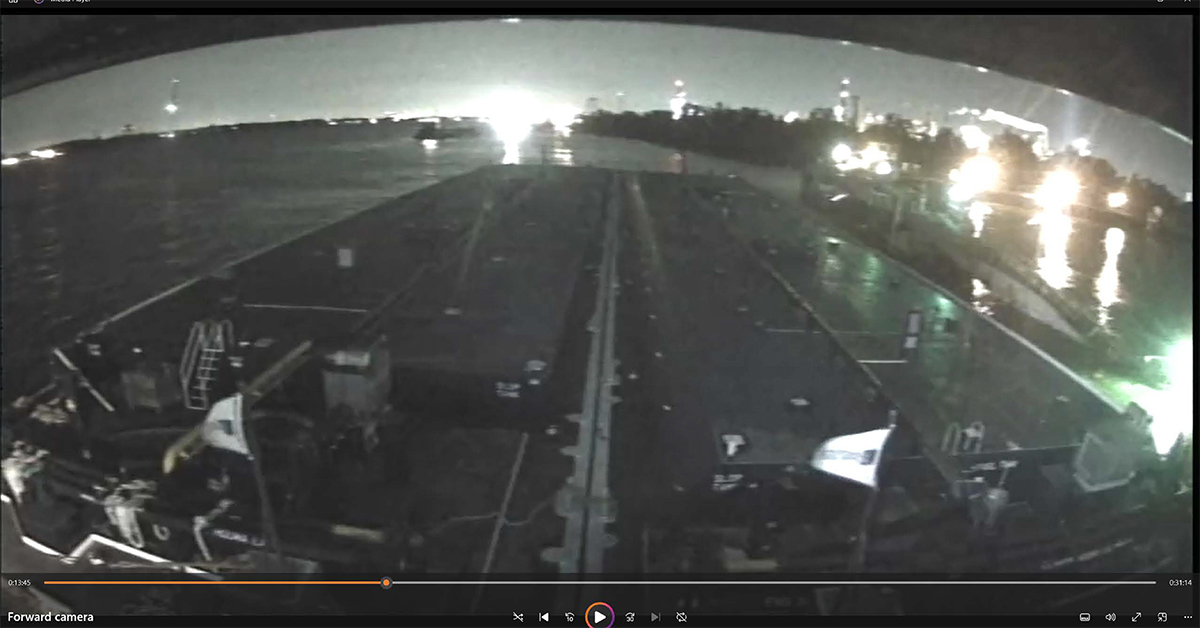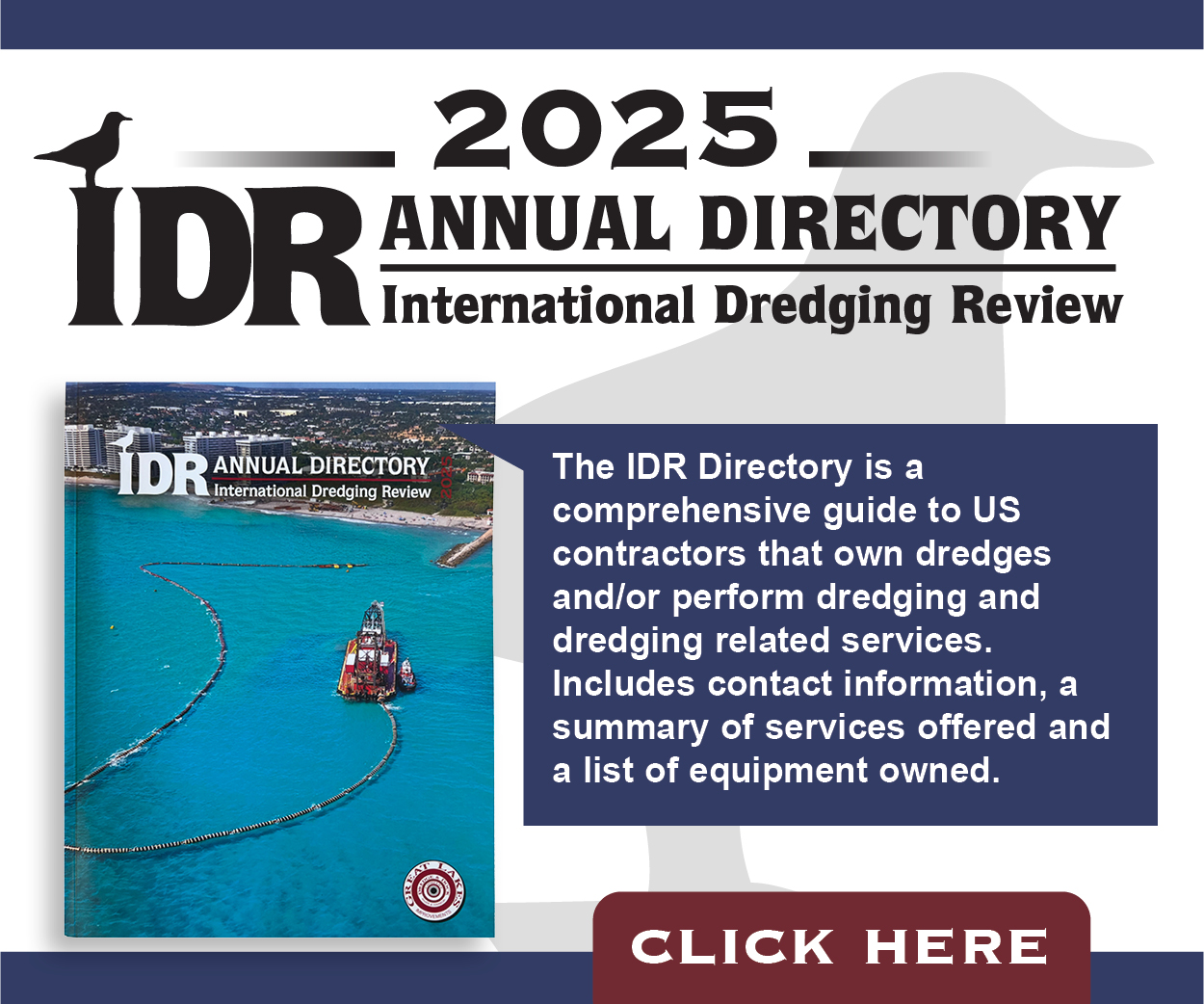Shortly after midnight on April 25, 2023, the mv. Ovide J was pushing a pair of loaded crude oil barges to Chalmette Refinery’s dock, located near Mile 89 on the Lower Mississippi River in St. Bernard Parish, La., when the starboard barge contacted the dock. After the impact, around 150 feet of the dock collapsed into the river. While there were no injuries and no reported pollution, the collapse damaged the dock’s pipelines, bridges and pilings, with repairs costing close to $7 million. After conducting an investigation into the event, the National Transportation Safety Board (NTSB) determined that the probable cause of the partial dock collapse was due to the degraded condition of the dock’s No. 3 dolphin transfer platform.
Built in 1998 and acquired by Enterprise Marine Services (EMS) in 2009, the Ovide J departed the Plains All American Oil Terminal in St. James Parish, La., shortly after noon on April 23, 2023, downbound for the Chalmette Refinery with the two loaded EMS barges and a crew of five on board. Later that day, the Ovide J arrived at a fleeting area near the Chalmette Refinery dock. The vessel’s voyage plan called for it to discharge 50,000 barrels of crude oil at the dock.
Around 10 p.m. on April 24, 2023, the captain of the Ovide J and the lead wharfman at the Chalmette Refinery dock confirmed an arrival for around midnight that night. At 10:28 p.m., the Ovide J left the fleeting area, which was about 1.6 miles upriver of the crude oil dock. The relief captain arrived in the wheelhouse just before 11:30 p.m. ahead of coming on watch at 11:45 p.m. The captain and relief captain then discussed the plan to continue past the crude oil dock, then “top around” to head the tow into the river’s current and approach the dock from downriver. The plan was to dock “starboard side to the pier,” according to the NTSB report.
The dock, built in 1967 and located on the left descending bank of the river, was made up of steel pilings, dolphins and elevated bridges, with a transfer platform at dolphin no. 3. Three 16-inch crude oil pipelines ran to dolphin No. 3. The dock offered a pair of berths, one “inshore” and one “offshore.”
The relief captain assumed the watch at 11:47 p.m. that night, with the captain remaining in the wheelhouse. According to the NTSB report, the relief captain had docked at the Chalmette Refinery crude oil dock 19 previous times, most recently just three days prior. Nine minutes later, at 11:56 p.m., the Ovide J was about 400 feet away from the dock and 150 downriver from the transfer platform. Over the next eight minutes, the Ovide J and its tow slowly maneuvered toward the platform, slightly overtaking it before letting the current take the tow back downriver. At 12:04 a.m. April 25, with the tow moving about 0.35 mph with the current and still facing upriver, the starboard quarter of the starboard barge “contacted the wooden fendering of the transfer platform at dolphin No. 3, and part of the dock collapsed into the river toward the shoreline,” the NTSB report stated. The NTSB noted in its report that the towboat’s onboard recording system captured “no signs of any movement from the contact (such as people getting jolted or VHF radio cables moving).” As soon as the dock collapsed, the relief captain placed the starboard engine in neutral “to avoid entanglement of the starboard propeller with the fallen dock and floating hoses and lines on the submerged transfer platform,” the report stated.
In the report, the relief captain explained that, because of the angle of the dock, “It’s not prudent mariner procedure to come in completely flat, so when you come in, you touch up stern first,” then bring the bow around. After the contact and collapse at dolphin No. 3, the relief captain ordered the deckhand, who was forward on the starboard barge, to secure as many lines as possible to the other two dolphins, which didn’t collapse. While the relief captain continued positioning the tow, the captain called EMS and the refinery to report the event.
Neither the Ovide J nor the barge sustained damage. According to the NTSB report, no fendering timbers or pilings sustained damage from the barge. The contact, though, caused 150 feet of the dock to collapse inshore. The transfer platform shifted about 30 feet and listed toward the bank at a 10-degree angle. The elevated bridge stayed connected to dolphin No. 3 but shifted about 17 degrees closer to the riverbank.
A July 2017 inspection noted “major deterioration” to several horizontal braces between pilings at dolphin No. 3, the NTSB reported. Two pilings were also noted as severely deteriorated, and the third-party engineering firm found that all of the pilings of dolphin No. 3 were shifted toward the shore. An above-water inspection in late 2021 noted “seven findings corresponding to damage, including disconnected header joints, bent beams and significant corrosion.” According to the dock owner, the recommendations from this inspection report had “not been progressed” as of the date the dock collapsed, the NTSB report stated.
In its “lessons learned” section of the report, the NTSB said it’s important for dock owners to “inspect, evaluate, maintain and rehabilitate facilities, piers, docks and other infrastructure to minimize the risk to the environment and the vessels that traverse the waterways.”
“Scheduling inspections, as well as maintaining and replacing waterfront infrastructure and components, is critical to continued safe operations,” the NTSB stated.




